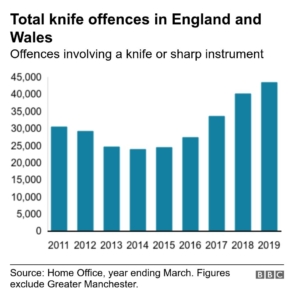Knife Defense – The Reality
When it comes to teaching real-world self-defense, we owe it to our students to keep things honest, current, and rooted in reality — not fantasy, ego, or outdated doctrine.
The Reality of Knife Crime in the UK
Knife crime isn’t just a headline-grabber — it’s a persistent and growing problem in the UK. In England and Wales alone, over 49,000 knife-related offences were recorded in the year ending September 2023 (ONS). That’s more than 130 knife offences per day. These aren’t just stats — they reflect a real threat, particularly in urban areas like London, Birmingham, and Manchester.
- Over 21,000 were assaults with injury or intent to cause serious harm.
- Around 19,000 involved knives used in robberies.
- Victims and offenders are increasingly young — with a notable rise in teenage girls involved in incidents either as attackers or victims.
- In the past year, nearly 7,000 under-18s were caught carrying a knife.
If you’re looking for realistic self-defence training in Bristol, this kind of context matters. You need more than technique — you need awareness, mindset, and pressure-tested skill.
Understanding the Attacks – What Does the Research Show?
Many people train for knife threats, not knife attacks. There’s a huge difference.
In real incidents, most knife attacks are:
- Fast, ferocious, and close-range.
- Often involve a “blitz” style — multiple rapid thrusts or slashes.
- The attacker is usually very close, often grabbing the victim with one hand while repeatedly stabbing with the other.
- The most common angles include straight thrusts (sewing machine style) and overhand stabs (ice pick style).
- Attacks are often ambushes, not fights — the defender may not even see the blade before being hit.
These patterns are backed up by UK police reports, forensic studies, and pressure-tested training data. This is not theory — it’s what happens on the street.
Not Just Knives – Bottles and Glass Matter Too
Weapons aren’t always blades. Around 1 in 4 violent incidents in the UK involve weapons, including:
- Broken bottles or pint glasses
- Improvised impact weapons (bats, bricks, hammers)
- Other stabbing tools (screwdrivers, scissors, pens, etc.)
Glassings are particularly brutal — spontaneous and aimed at the head or neck. If your training doesn’t account for this kind of violence, it’s incomplete.
Forget the Fantasy – Let’s Talk Survival
If your plan for a knife attack is to “just run” — that’s great if you have the chance. But real attacks often happen:
- Too close for a clean escape,
- Involving someone you care about,
- Or with a sudden grab-and-stab approach.
Sometimes, you may even have to run towards the danger to protect someone else. These are hard truths, but we owe it to ourselves to prepare for them.
At the same time, defending against a knife should always be the last resort. If you can:
- Avoid the situation — do it.
- De-escalate — try.
- Comply — within reason, especially in a robbery — do it.
But if your life or someone else’s is on the line, you may have no choice but to act.
How We Train Knife Defense: Simplicity, Aggression, and Realism
Effective knife defense isn’t about flashy moves; it’s about simple, aggressive, and pressure-tested techniques. Our approach focuses on:
- Simplicity Under Stress
Complex techniques often fail under real pressure. We prioritize direct, instinctive movements that hold up in chaotic conditions. - Aggressive Counterattacks
Blocking isn’t enough — we train to immediately transition from defense to offense. Striking back disrupts the attacker’s rhythm and buys critical time. - Use of Improvised Weapons
A belt, a coat, a bag — anything in your environment could be your shield. Training includes how to use everyday items when caught off-guard. - Realistic Drills and Pressure Testing
Knife defense is drilled with speed, aggression, and unpredictability. This isn’t theory — it’s about repeated exposure to high-adrenaline scenarios so your body learns to respond under stress.
This approach is consistent with pressure-tested self-defense systems that emphasize gross motor responses, aggression, and adaptability.
Knife Defense Is Only One Part of the Puzzle
Knife defense isn’t a standalone skill — it’s just one part of a much bigger picture. Real self-protection means developing multiple overlapping abilities:
- You need to be physically fit enough to run, fight, or recover. Try our Krav Maga workouts or conditioning sessions.
- You need to be used to adrenaline and pressure — not frozen by it.
- You need to train for multiple opponents and chaotic environments — not just 1-on-1 sparring.
- If you never strike under pressure, you won’t learn to stay calm or protect yourself in motion.
- If you don’t grapple, you won’t know how to escape a choke — that’s why we include combat grappling in our curriculum.
We take a holistic approach to training — because there’s no silver bullet. Just hard, honest, well-rounded work.
No Dogma – Just What Works
We’re not here to sell a style, a lineage, or a logo. People need to make up their own minds about what’s right for them. But we do believe this:
Training should reflect reality.
It should evolve based on what we know.
And it should prepare you for the worst, while hoping for the best.
We don’t have all the answers — and we’re okay with that. We’ll keep learning, pressure-testing, and refining. That’s what honest training looks like.
Stay safe. Train smart. Stay humble.
Jim

